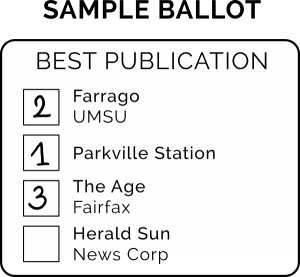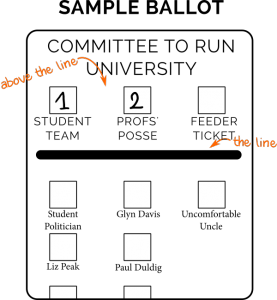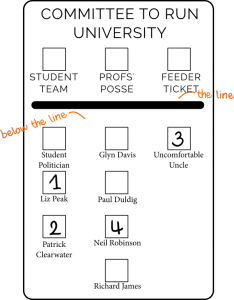UMSU elections 2016: what you want to know
Welcome to student election week.
If you’re a devoted reader of Parkville Station, you would have noticed that last semester there was an election for members of the Graduate Student Association. There were a couple of articles and a candidate spread in Parkville Station, a few posters around campus, and graduate students got an email with information about how to vote.
UMSU elections are nothing like that.
The UMSU website delicately describes the week as “lots of brightly coloured t-shirts campaigning for your affections”. While it is true that the T-shirts will solicit you to vote one way or another, those T-shirts will be filled with people who will solicit you somewhat more vociferously — and it ain’t your affections they’re after, it’s your vote.
Entrances to the three Parkville polling places — in Union House, the Baillieu Library, and the FBE Building — will be picketed by campaigning students in a variety of colours. Campaign styles vary from vaguely shouting at passers-by; to morosely handing out colourful “how-to-vote” fliers; to campaigners coming up to you, establishing a rapport and only then mentioning that after that great chat, maybe you’d think about throwing them a vote.
Some will campaign “on the line” — the “line” being the demarcation past which campaigners are forbidden to tread — making sure every student passing them gets a flier. Other campaigners will roam, identifying their prey (uhh, potential voters), flattering them, and walking them over the line. This approach scales to two — a campaigner for one side on your left, another on your right — but when it gets past two, it tends to descend into a group mobbing.
Tactics for getting through campaigners vary. A few popular ones are:
- Saying “I’ve already voted”. If you say this before 10am Monday, people will know you’re lying. But if you vote, you can say it with a clean conscience (and this is what we recommend).
- Saying you’re a University staff member. This only works if you also have a swanky blue University of Melbourne lanyard. (If you’re a staff member and a student, you can still vote, but “I’m staff” remains technically true and will dissuade newbie campaigners.)
- Saying you’re not from UniMelb. Curiously, the population of non-UniMelb people at UniMelb triples during election week.
- Use a less-known entrance to the building. Effective only when campaigner strength is lower, this is nevertheless a great opportunity to show off your knowledge of the University.
- Getting your hands on a campaign T-shirt. Wearing a campaign T-shirt is the most effective way to not be bothered by a campaigner from any ticket… and as an added bonus, no-one will willingly talk to you!
That said, we think you should sit down, study the options, and decide to vote for someone, or make a considered decision that none of the candidates are very good, and that you’re not going to vote. To that end, we’ve put a comparison of the tickets’ priorities, have our full election coverage as well as a practise voting tool.
Tell me more about voting
Glad you asked. Meet Alex. Alex is a first year Bachelor of Basketweaving student who will be voting for the first time. Armed with a handy copy of Parkville Station (no real reason, just good for swatting away campaigners), Alex heads in to Union House, deftly sidestepping campaigners (one of whom accidentally crosses “the line” into Union House, and promptly evaporates).
After locating the polling place (in Union House, it’s in the Lounge on the north side of the building), Alex joins the queue. Queue lengths vary: lunch times, and the time that polling booths open and close, are the peak times; other than that it tends to be a steady stream. (Accepted wisdom is that Friday is the busiest day.)
After only a short time (Alex is good at predicting queues like that), upon reaching the front, a polling clerk (person at the table at the front of the queue) asks for Alex’s student card (don’t forget your student card), asks a few preliminary questions (“Have you voted in this election before?” — hopefully the answer is ‘no’), and gives Alex a quick rundown on how to vote.
Here’s where we get a bit didactic, and break out the charts and pictures.
Ballots come in two types. For “single member positions” (positions where only one person, or one team, will be elected), they’ll look roughly like this:

There are names of candidates (here, rather than people, we’ve used names of publications); and their “tickets” (political parties — again, we’ve used examples rather than real ones).
All you need to do is write numbers in the boxes next to the candidate(s) you want to win — with “1” next to the candidate you most want, and so on. You can number as many or as few as you wish.
For “multimember positions” (like committees, where multiple people will be elected), the ballot looks a bit bigger and a bit scarier, like this (voting above the line):

And like this (voting below the line):

You have three options about how you vote:
Vote above the line (marked “Above the line” above) for a single ticket — to do this, you just put a “1” next to that ticket’s name. Pros: quick. Cons: you’ll automatically adopt that ticket’s preferences for who to elect, which you may or may not agree with. (See where each ticket’s preferences will flow on page 7.) Parkville Station recommendation: put more effort into voting than this.
Vote above the line for multiple tickets — to do this, put a “1” next to the ticket you most like, then “2” next to ticket you like second-most, and so on (you can number as many or as few boxes as you like). This is a vote for the people on ticket #1 first, then the people on ticket #2, and so forth. If you vote like this, the ticket’s preferences are irrelevant — only what you vote for counts, though you can’t preference specific people within tickets. Parkville Station recommendation: this is a good way to vote, for normal people.
Vote below the line (marked “Below the line” above) — to do this, number candidates below the line (in any order you want, no need to follow a ticket). This gives you the most control, but takes forever. Parkville Station recommendation: vote this way if you’re a geek, or if you’ve got a good friend running for something.
You can leave some or all of the ballot papers blank, if you want.
If you’d like to do this in the safety of your own home, Parkville Station has developed a handy practice voting tool.
Back to our story. Once Alex has finished filling in the ballot, Alex drops it in the ballot box and heads off.
Now Alex has voted. Alex used the Parkville Station practice voting tool. Alex is smart. Be like Alex.